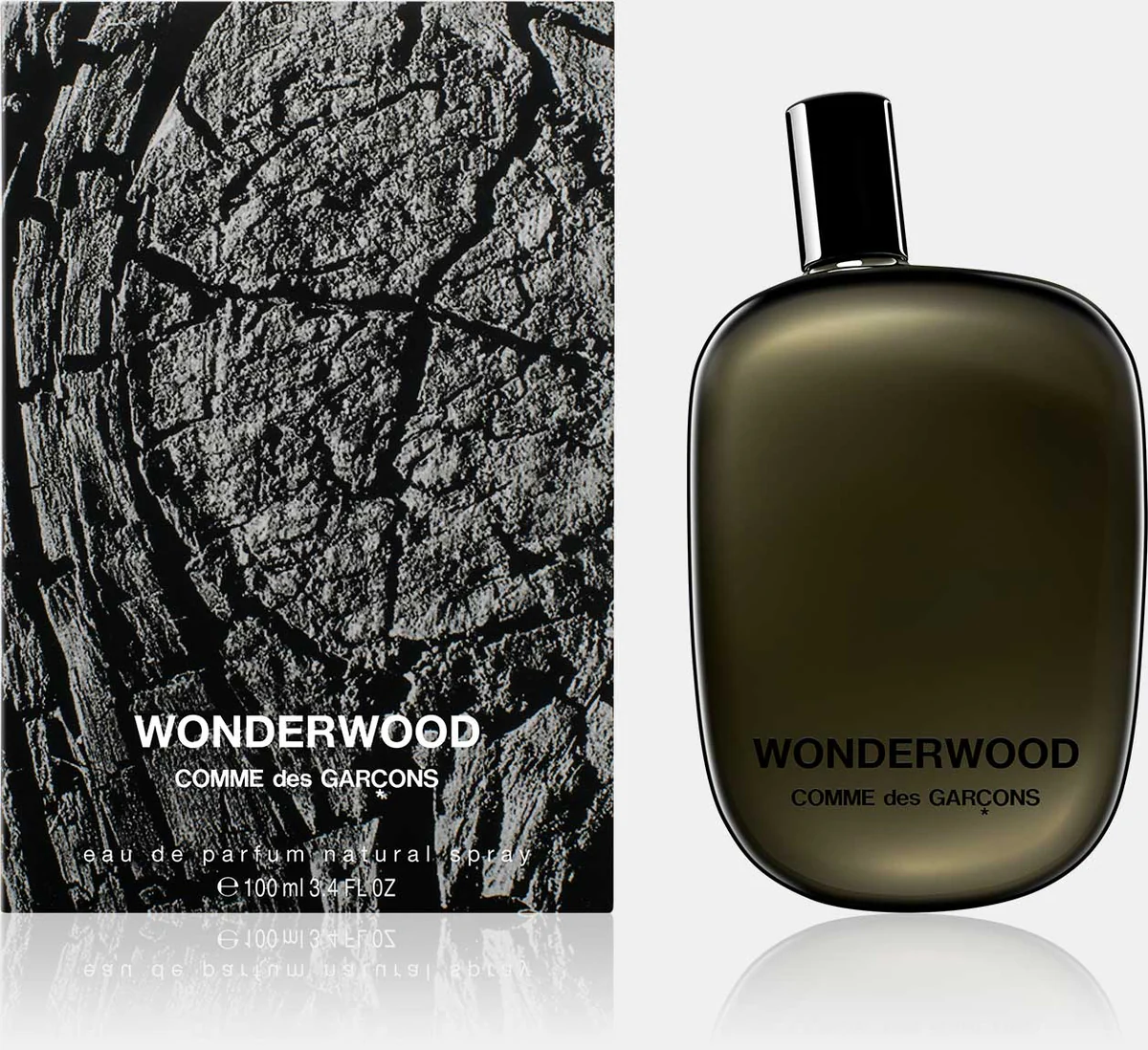love4livi.com – Comme des Garçons is a fashion brand that has long been known for its avant-garde approach to both fashion and fragrance. Established in 1969 by designer Rei Kawakubo, the brand is a pioneer in pushing the boundaries of design and art, often blurring the lines between the two. This ethos is perfectly reflected in their fragrance offerings, which range from the unconventional to the purely sublime. One such fragrance that encapsulates the brand’s bold and innovative spirit is Wonderwood, a perfume that celebrates the raw and diverse facets of wood.
Released in 2010, Comme des Garçons Wonderwood quickly became a standout fragrance in the brand’s portfolio. It’s a perfume that is both complex and approachable, offering a unique perspective on woody notes and blending them into a scent that feels fresh yet earthy, modern yet timeless. In this article, we will dive deep into the story behind Wonderwood, explore its intricate composition, and understand why it has become a beloved scent among both perfume connoisseurs and newcomers alike.
The Concept and Inspiration Behind Wonderwood
Wonderwood was born out of a fascination with wood in all its forms. Known for their ability to create fragrances that evoke specific moods or ideas, Comme des Garçons chose to create a perfume that would act as a tribute to wood—a material that is rich with symbolism, history, and versatility. Wood has long been a staple in the world of perfumery due to its warm, earthy, and often grounding qualities. However, Comme des Garçons set out to create something different with Wonderwood—something that would not only highlight the traditional elements of wood but also explore the diverse and unexpected aspects of this natural material.
The idea behind Wonderwood was to capture a range of wood-related aromas and bring them together into a harmonious whole, exploring both the softer and more intense facets of wood. Rather than focusing on a single type of wood, the fragrance blends a variety of woody notes—both fresh and dry, warm and cool—creating a multidimensional experience that reflects the complexity of wood as a material.
It’s a fragrance that evokes a sense of mystery, intrigue, and natural beauty, with a composition that encourages the wearer to engage with it on a deeper level. Wonderwood is not a simple or linear fragrance; it’s one that unfolds over time, revealing different layers and facets with each wear.
The Composition and Scent Profile of Wonderwood
Comme des Garçons Wonderwood is classified as a woody fragrance, but it’s much more than just a straightforward interpretation of wood. Its composition is rich, multifaceted, and unexpected, offering a combination of traditional woody notes with more unusual, abstract elements. The fragrance invites the wearer to experience wood in all its raw and refined forms, blending different types of wood with spices, florals, and even aquatic notes to create something that is both earthy and sophisticated.
Top Notes:
- Spices (Coriander, Cardamom, and Nutmeg)
- Citrus (Bergamot)
Wonderwood opens with a spicy burst of coriander, cardamom, and nutmeg. These spices introduce an immediate warmth and depth to the fragrance, adding a slight peppery, aromatic quality that feels both vibrant and comforting. The citrus note of bergamot adds a touch of brightness to the opening, providing a clean, fresh contrast to the richness of the spices. The result is an opening that feels both energetic and inviting, capturing the dynamic tension between warmth and freshness.
The spices give Wonderwood an intriguing complexity from the very first spritz, hinting at the depth and multifaceted nature of the fragrance to come. The opening is lively but never overwhelming, setting the stage for the more complex heart and base notes to emerge.
Heart Notes:
- Cedarwood
- Sandalwood
- Violet
- Orris Root
As Wonderwood transitions into the heart, the fragrance begins to take on a more distinctly woody character. Cedarwood and sandalwood provide the foundation, with the cedarwood offering a dry, slightly smoky, and resinous quality, while the sandalwood brings a creamy, soft warmth. Together, these two woods create a smooth, balanced base that grounds the fragrance.
However, Wonderwood is not simply about the obvious woody notes—it introduces a more unexpected element with the inclusion of violet and orris root. Violet adds a delicate, slightly floral facet to the heart of the fragrance, creating an interesting contrast with the earthy, woody notes. The orris root, with its powdery, slightly iris-like quality, lends an air of elegance and refinement to the heart of the perfume, giving it a sophisticated, almost vintage feel. These florals add a layer of depth and complexity, keeping the fragrance from feeling too one-dimensional.
Base Notes:
- Patchouli
- Vetiver
- Agarwood (Oud)
- Cedar
- Vetiver
- Musk
In the drydown, Wonderwood evolves into a rich, earthy, and slightly smoky composition. Patchouli, a classic ingredient in woody fragrances, adds a dark, earthy richness that gives the fragrance its grounding, almost mystical quality. The inclusion of vetiver adds a grassy, slightly smoky edge, complementing the other base notes with its rugged, earthy character.
One of the standout elements of the base is the use of agarwood (oud), which adds a deep, resinous richness to the fragrance. The oud here is not overpowering or too heavy, as it can be in some other fragrances, but rather a refined, nuanced presence that adds an intriguing smokiness. Together with the cedarwood, which continues to make its presence felt in the base, and the soft musk that gives the fragrance a smooth, clean finish, the base of Wonderwood is both deep and inviting, wrapping the wearer in a warm, earthy embrace.
The Unconventional Nature of Wonderwood
What sets Wonderwood apart from other woody fragrances is its ability to seamlessly combine the familiar and the unusual. It’s not a straightforward woody scent; it’s a complex blend that defies typical expectations. While it’s grounded in woody notes, it also brings in a range of other elements that add depth, complexity, and intrigue.
For example, the use of violet and orris root in the heart of the fragrance is a daring move, as these floral and powdery notes are rarely associated with the typically dry and resinous nature of wood. These elements add an unexpected softness and refinement, creating an intriguing contrast to the more traditional, rougher woody elements.
The addition of spices in the opening also gives Wonderwood an unconventional edge. Rather than starting with the typical green or citrus notes often seen in woody fragrances, Wonderwood introduces an aromatic, spicy opening that feels fresh and vibrant. This combination of spices with wood and florals creates a scent that is both modern and timeless, offering something unique for those who are drawn to complex, multifaceted perfumes.
Wearability and Versatility
While Wonderwood is undeniably bold and daring, it’s also surprisingly wearable. Its balanced composition means it can be worn in a variety of settings—whether in the office, during a night out, or at a special event. The fragrance’s complexity makes it a great choice for those who want something more unique than the typical mass-market scents, while its warmth and earthiness make it perfectly suited for the cooler months.
Wonderwood is also versatile in that it is unisex, appealing to both men and women who appreciate woody fragrances with depth and character. It’s a scent that exudes confidence and sophistication without being overwhelming, and its layered complexity makes it perfect for those who enjoy fragrances that evolve over time.
Packaging and Presentation
As is typical with Comme des Garçons, the packaging for Wonderwood is sleek and minimalist, reflecting the brand’s modern sensibilities. The bottle is simple and clear, allowing the deep amber liquid inside to shine. The label is understated, with the name “Wonderwood” printed in bold, black letters across the front of the bottle, allowing the fragrance to speak for itself without any unnecessary adornment.
The simplicity of the packaging is a perfect complement to the fragrance itself—modern, elegant, and stripped of any excess, allowing the focus to remain squarely on the scent within.
Why Wonderwood Stands Out
Comme des Garçons Wonderwood stands out in the world of woody fragrances because of its bold, unconventional approach to the genre. It’s not afraid to experiment with a wide range of ingredients, from spices to florals to smoky oud, creating a fragrance that is multi-dimensional and full of surprises. Its complexity, combined with its wearability, makes it a perfect choice for those who enjoy fragrances that are both unique and sophisticated.
Wonderwood is a fragrance that challenges expectations, offering a refreshing take on what a woody perfume can be. It’s a scent that invites exploration, constantly evolving and revealing new facets with each wear. Whether you are a seasoned perfume lover or someone just beginning to explore the world of niche fragrances, Wonderwood offers a unique olfactory experience that is sure to captivate and intrigue.
Conclusion
Comme des Garçons Wonderwood is a fragrance that pushes the boundaries of what a woody perfume can be. With its bold, multifaceted composition that blends spices, florals, and resins with a variety of woody notes, it offers a complex and captivating olfactory experience. Wonderwood is not just a scent; it’s a journey into the heart of wood itself, exploring both its familiar and unexpected aspects. Its depth, warmth, and modern sensibility make it a standout fragrance that appeals to anyone seeking a sophisticated, avant-garde take on the woody genre.
Whether worn casually or for a special occasion, Wonderwood offers a scent experience that evolves with the wearer, creating an intimate, ever-changing aura. It is a fragrance that stands out not just for its boldness, but for its ability to create an immersive, timeless experience that is both grounded and full of surprises.






